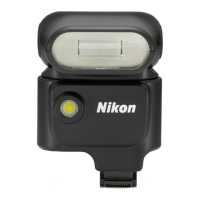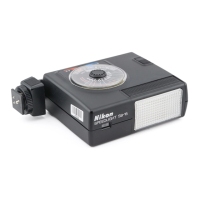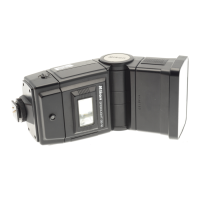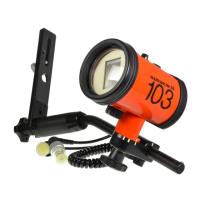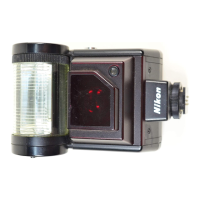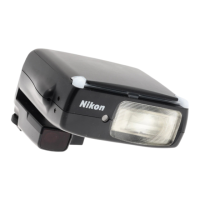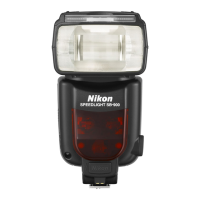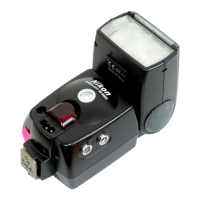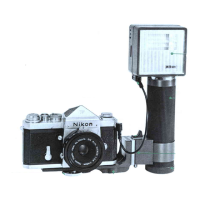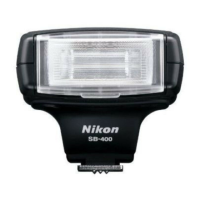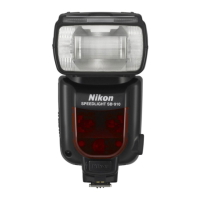Do you have a question about the Nikon Speedlight SB-700 and is the answer not in the manual?
Guidance on navigating the manual to locate specific information.
Essential safety precautions to be read before using the speedlight.
Details about the Nikon Speedlight SB-700's features and capabilities.
List of Nikon cameras compatible with the Creative Lighting System (CLS).
Information on the assumptions and scope of the user manual.
Guidance on how to identify CPU NIKKOR lenses.
Definitions of key terms and concepts used in the manual.
Questions and answers related to flash photography with the SB-700 mounted on camera.
Questions and answers regarding flash photography using the SB-700 wirelessly.
Critical warnings regarding the safe handling and operation of speedlights.
Precautions for speedlight operation to avoid damage or hazards.
Important warnings related to the handling and use of batteries.
Precautions for handling batteries to prevent potential hazards.
Recommendations for optimal use and regular maintenance of the speedlight.
Information on accessing ongoing product support and educational resources.
Identification and description of the various parts of the speedlight.
Important notes regarding the use of the speedlight for continuous flash photography.
Step-by-step instructions for correctly inserting the batteries.
Information on the types of batteries suitable for use with the speedlight.
Guidance on when to replace or recharge batteries.
Explanation of the low battery power indicator on the LCD.
Step-by-step instructions for attaching the speedlight to the camera.
Instructions for safely detaching the speedlight from the camera.
Step-by-step guide for adjusting the flash head position.
Instructions for powering on the speedlight and camera.
Step-by-step instructions for selecting the flash mode.
Details on how to configure custom settings for the speedlight.
Overview of the custom functions and their default settings.
How to adjust the contrast of the LCD panel.
Information on the automatic standby function to conserve battery power.
Setting the FX/DX format selection for image area.
Setting the flash compensation step in manual flash mode.
Setting the unit of measuring distance (meters or feet).
Enabling or canceling the AF-assist illumination function.
Displaying the current firmware version of the speedlight.
Procedure for resetting custom settings to default.
Information about the i-TTL flash mode, including monitor pre-flashes.
Explanation of the i-TTL balanced fill-flash mode for balanced exposure.
Explanation of the standard i-TTL mode for main subject exposure.
How camera metering modes affect i-TTL mode operation.
Instructions for setting the speedlight to i-TTL mode.
Explanation of the effective flash output distance range display on the LCD.
Automatic setting of camera parameters based on lens and camera information.
How to interpret and compensate for insufficient flash output.
Instructions for setting the speedlight to manual flash mode.
Guide on how to take pictures using manual flash mode.
Procedure for adjusting the flash output level in manual mode.
Instructions for setting the distance-priority manual flash mode.
Example display of the LCD in distance-priority manual flash mode.
Guide on taking pictures using distance-priority manual flash mode.
Troubleshooting for the bounce flash warning indicator.
Understanding the flash-to-subject distance range in this mode.
Interpreting and compensating for insufficient flash output in this mode.
Initial setup for wireless multiple flash-unit photography with the SB-700.
Detailed guide to setting up and using Advanced Wireless Lighting.
Instructions for SU-4 type wireless multiple flash-unit photography.
Overview of the SB-700's functions in wireless multiple flash photography.
Important notes regarding canceling the master flash unit's function.
Steps for taking pictures using Advanced Wireless Lighting.
Instructions on how to cancel the flash function in i-TTL and manual modes.
Setting the group, channel, and zoom head position for remote flash units.
Steps to set up and configure quick wireless control mode.
Guide on how to take pictures using quick wireless control mode.
Instructions for setting up SU-4 type wireless photography.
Available flash modes (AUTO, M, OFF) for remote flash units in SU-4.
Details on using the AUTO mode for SU-4 wireless photography.
Details on using the M (manual) mode for SU-4 wireless photography.
Using the OFF mode to cancel flash function in SU-4 photography.
Configuring a remote flash unit for SU-4 type wireless photography.
General settings and considerations for remote flash units.
Guidance on the physical setup and positioning of remote flash units.
Using indicators to check the status of wireless flash operations.
Guide to selecting different illumination patterns for flash photography.
Techniques and tips for using bounce flash photography.
Methods for achieving good results in close-up flash photography.
Using color filters to enhance flash photography.
Overview of various functions that support flash photography.
Camera-specific functions that enhance speedlight operation.
Description of the center-weighted illumination pattern.
Description of the even illumination pattern.
Instructions on how to select the illumination pattern using the selector.
Guide on how to adjust the flash head's tilt and rotation angles.
Tips for setting angles and selecting surfaces for effective bounce flash.
Information on using the Nikon Diffusion Dome for softer light.
Understanding the zoom head position indicator on the LCD.
Steps for capturing images using bounce flash techniques.
Guidance on setting the aperture for optimal bounce flash exposure.
How to use the built-in bounce card for portrait subjects.
Instructions for extending and positioning the built-in wide panel.
Guide to taking close-up shots using bounce-down flash.
Overview of included and optional filters for color compensation.
Instructions for attaching the included color compensation filters.
Instructions for attaching the optional SJ-4 color filters.
How to select the attached color filter in custom settings.
Important notes regarding the use and maintenance of SJ-4 color filters.
Using filters to balance light and adjust white balance.
How white balance settings vary based on the camera model and filter.
Adjusting flash output level to compensate exposure without affecting background.
Procedure for canceling flash compensation settings.
Using flash compensation on cameras with built-in flash capabilities.
How the speedlight automatically adjusts zoom head position to lens focal length.
Instructions for manually adjusting the zoom head position.
Using AF-assist illumination to enable autofocus in low light.
Important notes regarding the usage and compatibility of AF-assist illumination.
Activating or canceling the AF-assist illumination feature.
Troubleshooting steps when autofocus fails despite AF-assist illumination.
Achieving autofocus with the SB-700 used off-camera.
Interaction between camera's built-in flash AF-assist and SB-700's.
Using the test firing button to check speedlight operation.
How modeling illumination works for checking lighting and shadows.
Modeling illumination behavior in Advanced Wireless Lighting.
Modeling illumination behavior in SU-4 type wireless photography.
Explanation of the standby function for battery conservation.
Function to protect the speedlight from overheating damage.
Using high-speed sync for flash synchronization at the camera's highest shutter speed.
Locking flash exposure to maintain subject illumination despite composition changes.
Using slow shutter speeds for correct exposure in low-light situations.
Preventing red-eye in low-light photos with three pre-flashes.
Creating blur effects behind moving subjects by firing flash at rear curtain.
Comparison of functions available with CLS and non-CLS compatible cameras.
Overview of flash modes and functions when using with COOLPIX cameras.
Information on wireless multiple flash-unit photography with CLS-compatible COOLPIX cameras.
How zoom head position is adjusted automatically with CLS-COOLPIX cameras.
Guidance for diagnosing and resolving common problems with the speedlight.
Troubleshooting table for various issues like zoom head position and remote flash unit firing.
Explanation of various warning indicators and their causes/solutions.
Consequences and actions if the built-in wide panel is damaged.
Explanation of guide numbers and their relationship to aperture and distance.
General advice on cleaning and maintaining the speedlight.
Recommendations for proper storage of the speedlight to prevent damage.
Guidance on suitable operating environments and avoiding hazards.
Important information and precautions regarding battery usage.
Information on the characteristics and operation of the LCD panel.
Instructions on how to download and update the speedlight firmware.
Details about the TTL Remote Cord SC-28/17 for off-camera use.
Details about the TTL Remote Cord SC-29 with AF-assist illumination.
Effective flash output distance ranges for i-TTL mode based on settings.
Effective flash output distance ranges table for FX format, standard pattern.
Angle of coverage data for FX format at various zoom head positions.
Angle of coverage data for DX format at various zoom head positions.
Guide number data for FX format across various settings.
Guide number data with auto FP high-speed sync for FX format.
Table showing minimum flashes and recycling times for different battery types.
Guidance on navigating the manual to locate specific information.
Essential safety precautions to be read before using the speedlight.
Details about the Nikon Speedlight SB-700's features and capabilities.
List of Nikon cameras compatible with the Creative Lighting System (CLS).
Information on the assumptions and scope of the user manual.
Guidance on how to identify CPU NIKKOR lenses.
Definitions of key terms and concepts used in the manual.
Questions and answers related to flash photography with the SB-700 mounted on camera.
Questions and answers regarding flash photography using the SB-700 wirelessly.
Critical warnings regarding the safe handling and operation of speedlights.
Precautions for speedlight operation to avoid damage or hazards.
Important warnings related to the handling and use of batteries.
Precautions for handling batteries to prevent potential hazards.
Recommendations for optimal use and regular maintenance of the speedlight.
Information on accessing ongoing product support and educational resources.
Identification and description of the various parts of the speedlight.
Important notes regarding the use of the speedlight for continuous flash photography.
Step-by-step instructions for correctly inserting the batteries.
Information on the types of batteries suitable for use with the speedlight.
Guidance on when to replace or recharge batteries.
Explanation of the low battery power indicator on the LCD.
Step-by-step instructions for attaching the speedlight to the camera.
Instructions for safely detaching the speedlight from the camera.
Step-by-step guide for adjusting the flash head position.
Instructions for powering on the speedlight and camera.
Step-by-step instructions for selecting the flash mode.
Details on how to configure custom settings for the speedlight.
Overview of the custom functions and their default settings.
How to adjust the contrast of the LCD panel.
Information on the automatic standby function to conserve battery power.
Setting the FX/DX format selection for image area.
Setting the flash compensation step in manual flash mode.
Setting the unit of measuring distance (meters or feet).
Enabling or canceling the AF-assist illumination function.
Displaying the current firmware version of the speedlight.
Procedure for resetting custom settings to default.
Information about the i-TTL flash mode, including monitor pre-flashes.
Explanation of the i-TTL balanced fill-flash mode for balanced exposure.
Explanation of the standard i-TTL mode for main subject exposure.
How camera metering modes affect i-TTL mode operation.
Instructions for setting the speedlight to i-TTL mode.
Explanation of the effective flash output distance range display on the LCD.
Automatic setting of camera parameters based on lens and camera information.
How to interpret and compensate for insufficient flash output.
Instructions for setting the speedlight to manual flash mode.
Guide on how to take pictures using manual flash mode.
Procedure for adjusting the flash output level in manual mode.
Instructions for setting the distance-priority manual flash mode.
Example display of the LCD in distance-priority manual flash mode.
Guide on taking pictures using distance-priority manual flash mode.
Troubleshooting for the bounce flash warning indicator.
Understanding the flash-to-subject distance range in this mode.
Interpreting and compensating for insufficient flash output in this mode.
Initial setup for wireless multiple flash-unit photography with the SB-700.
Detailed guide to setting up and using Advanced Wireless Lighting.
Instructions for SU-4 type wireless multiple flash-unit photography.
Overview of the SB-700's functions in wireless multiple flash photography.
Important notes regarding canceling the master flash unit's function.
Steps for taking pictures using Advanced Wireless Lighting.
Instructions on how to cancel the flash function in i-TTL and manual modes.
Setting the group, channel, and zoom head position for remote flash units.
Steps to set up and configure quick wireless control mode.
Guide on how to take pictures using quick wireless control mode.
Instructions for setting up SU-4 type wireless photography.
Available flash modes (AUTO, M, OFF) for remote flash units in SU-4.
Details on using the AUTO mode for SU-4 wireless photography.
Details on using the M (manual) mode for SU-4 wireless photography.
Using the OFF mode to cancel flash function in SU-4 photography.
Configuring a remote flash unit for SU-4 type wireless photography.
General settings and considerations for remote flash units.
Guidance on the physical setup and positioning of remote flash units.
Using indicators to check the status of wireless flash operations.
Guide to selecting different illumination patterns for flash photography.
Techniques and tips for using bounce flash photography.
Methods for achieving good results in close-up flash photography.
Using color filters to enhance flash photography.
Overview of various functions that support flash photography.
Camera-specific functions that enhance speedlight operation.
Description of the center-weighted illumination pattern.
Description of the even illumination pattern.
Instructions on how to select the illumination pattern using the selector.
Guide on how to adjust the flash head's tilt and rotation angles.
Tips for setting angles and selecting surfaces for effective bounce flash.
Information on using the Nikon Diffusion Dome for softer light.
Understanding the zoom head position indicator on the LCD.
Steps for capturing images using bounce flash techniques.
Guidance on setting the aperture for optimal bounce flash exposure.
How to use the built-in bounce card for portrait subjects.
Instructions for extending and positioning the built-in wide panel.
Guide to taking close-up shots using bounce-down flash.
Overview of included and optional filters for color compensation.
Instructions for attaching the included color compensation filters.
Instructions for attaching the optional SJ-4 color filters.
How to select the attached color filter in custom settings.
Important notes regarding the use and maintenance of SJ-4 color filters.
Using filters to balance light and adjust white balance.
How white balance settings vary based on the camera model and filter.
Adjusting flash output level to compensate exposure without affecting background.
Procedure for canceling flash compensation settings.
Using flash compensation on cameras with built-in flash capabilities.
How the speedlight automatically adjusts zoom head position to lens focal length.
Instructions for manually adjusting the zoom head position.
Using AF-assist illumination to enable autofocus in low light.
Important notes regarding the usage and compatibility of AF-assist illumination.
Activating or canceling the AF-assist illumination feature.
Troubleshooting steps when autofocus fails despite AF-assist illumination.
Achieving autofocus with the SB-700 used off-camera.
Interaction between camera's built-in flash AF-assist and SB-700's.
Using the test firing button to check speedlight operation.
How modeling illumination works for checking lighting and shadows.
Modeling illumination behavior in Advanced Wireless Lighting.
Modeling illumination behavior in SU-4 type wireless photography.
Explanation of the standby function for battery conservation.
Function to protect the speedlight from overheating damage.
Using high-speed sync for flash synchronization at the camera's highest shutter speed.
Locking flash exposure to maintain subject illumination despite composition changes.
Using slow shutter speeds for correct exposure in low-light situations.
Preventing red-eye in low-light photos with three pre-flashes.
Creating blur effects behind moving subjects by firing flash at rear curtain.
Comparison of functions available with CLS and non-CLS compatible cameras.
Overview of flash modes and functions when using with COOLPIX cameras.
Information on wireless multiple flash-unit photography with CLS-compatible COOLPIX cameras.
How zoom head position is adjusted automatically with CLS-COOLPIX cameras.
Guidance for diagnosing and resolving common problems with the speedlight.
Troubleshooting table for various issues like zoom head position and remote flash unit firing.
Explanation of various warning indicators and their causes/solutions.
Consequences and actions if the built-in wide panel is damaged.
Explanation of guide numbers and their relationship to aperture and distance.
General advice on cleaning and maintaining the speedlight.
Recommendations for proper storage of the speedlight to prevent damage.
Guidance on suitable operating environments and avoiding hazards.
Important information and precautions regarding battery usage.
Information on the characteristics and operation of the LCD panel.
Instructions on how to download and update the speedlight firmware.
Details about the TTL Remote Cord SC-28/17 for off-camera use.
Details about the TTL Remote Cord SC-29 with AF-assist illumination.
Effective flash output distance ranges for i-TTL mode based on settings.
Effective flash output distance ranges table for FX format, standard pattern.
Angle of coverage data for FX format at various zoom head positions.
Angle of coverage data for DX format at various zoom head positions.
Guide number data for FX format across various settings.
Guide number data with auto FP high-speed sync for FX format.
Table showing minimum flashes and recycling times for different battery types.
| Vari-Power | 1/1 to 1/128 |
|---|---|
| Type | Shoe Mount |
| Color Temperature Information Communication | Yes |
| LCD Panel | Yes |
| Guide Number | 28 m/92 ft at ISO 100 (35mm) |
| Zoom Range | 24-120mm |
| Flash Duration | 1/1042 sec at full power |
| Exposure Control | i-TTL |
| Bounce Head | Yes, -7 to 90 degrees |
| Swivel Head | Yes, 180 degrees left or right |
| Power Source | 4 x AA batteries |
| Weight | 360 g without batteries |
| Recycle Time | 2.5 sec (NiMH) |
| Flash Modes | TTL, Manual, Repeating |
| Wireless Operation | Yes; Commander and Remote modes |
